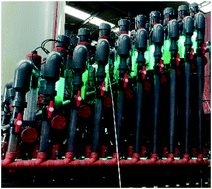Comparative study of PFAS treatment by UV, UV/ozone, and fractionations with air and ozonated air†
Abstract
Per- and poly-fluorinated alkyl substances (PFAS) and their derivatives are persistent organic chemicals that result in significant adverse human health and environmental effects. In this paper, UV, ozonated air fractionation, air fractionation and combined UV/ozone treatment for PFAS removal were studied and compared. The feed water was synthesized from firefighting foam, which contained multiple per- and poly-fluorinated alkyl substances. Combined UV and ozone equipment patented by EGL were used to compare the performance of the different treatment methods, in which a two-unit rig was employed as a benchtop setup and a nine-unit rig using UV/ozone combined treatment was employed as a pilot rig. It was found from the benchtop tests that the PFAS removal efficiency was improved with the increase in air and feed flow rates in the UV/ozone combined treatment. The highest PFAS removal efficiency achieved was 87% at an air flow rate of 30 L min−1 and a feed flow rate of 1.4 L min−1 (10 min residence time). The different treatment techniques, including UV only, ozonated air fractionation, and air fractionation, were compared with the UV/ozone combined treatment at the residence time of 20 min. UV alone removed 16.8% PFAS, which showed the worst performance of all tests. The UV/ozone combined treatment removed 73% PFAS, and air fractionation was able to achieve 81% PFAS removal. Ozonated air fractionation showed the best PFAS removal efficiency, which was more than 95%, as a result of the enriched OH radicals in the gas bubbles. For the nine-unit pilot rig, the UV/ozone combined treatment achieved about 79% PFAS removal. However, foam fractionation occurred during the treatment, which led to approximately 4% removal of PFAS based on the mass balance. Therefore, the PFAS removal contributed by UV and ozone combined treatment was 75%, which was similar to the result from the benchtop rig. All treatment resulted in a concentration increase in at least one type of short-chain PFAS. When foam fractionation with gas bubbles occurred in the treatment, it was easier to remove perfluoroalkyl sulfonate (PFSA) than perfluoroalkyl carboxylate (PFCA) because PFSA is more hydrophobic than PFCA, which gives it more affinity for gas bubbles. In addition, in comparison with long-chain PFAS it is much more difficult to remove the short-chain PFAS by fractionation technologies, due to the partition factor declining exponentially with the reduced carbon number.

- This article is part of the themed collections: PFAS and Best Papers 2019 – Environmental Science: Water Research & Technology


 Please wait while we load your content...
Please wait while we load your content...